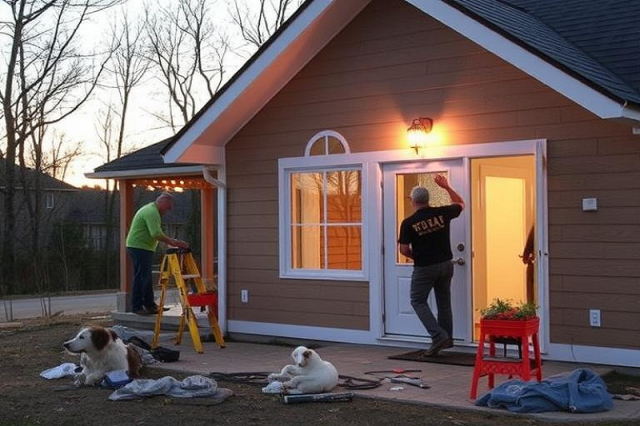Have you ever noticed your wooden floors starting to sag or your doors refusing to close smoothly? Do the words “house stumps” bring up questions about what’s literally holding your home steady? You’re not alone. Many Australian homeowners aren’t sure how much their home’s structural safety depends on the condition of its stumps.
In this blog post, we’ll explore how restumping a house can dramatically improve your home’s foundations. We’ll look at the warning signs of stump failure, discuss the advantages of building a house on stumps, and show you how to level a house on stumps if things start to shift. We’ll also walk through the restumping process, from selecting the right materials—such as timber house stumps or treated pine stumps—to wrapping up with maintenance tips that keep your new stumps in top shape.
By the end of this post, you’ll have a strong grasp of what’s involved in house stump replacement, why it’s crucial for structural safety, and whether restumping could be covered by insurance. Plus, we’ll check out alternatives to restumping in Australia in case your home could benefit from another approach. Let’s begin by understanding what restumping really is, why it matters, and how to recognise the signs that it’s time to shore up your home’s support system.
2. Understanding Restumping a House
Restumping a house might not be something you think about every day. Yet it plays a key role in making sure your home stays level, safe, and free from structural problems. House stumps are the sturdy supports that prop up your home’s floors and transfer the weight evenly across the ground. If these become compromised, your entire property can suffer.
2.1 What Is House Restumping and Why Is It Important?
House restumping, also known as reblocking, involves removing old, damaged, or failing stumps and replacing them with fresh supports. These supports could be made of timber stumps, concrete, or even galvanised steel, depending on what suits your home’s design and the local soil conditions. The reason it’s so important is that failing stumps can lead to uneven floors, cracked walls, or jamming windows and doors. By swapping out damaged supports, you’re investing in the long-term stability of your home.
2.2 Common Reasons for Stump Failure
Stump failure often happens for a few key reasons:
- Wood rot and termite damage, which particularly threaten older timber house stumps.
- Shifting or unstable soil, where constant moisture changes can make stumps sink or tilt.
- Poor-quality materials or older stumps that have simply reached the end of their lifespan.
When stumps no longer do their job, your home may begin to twist or settle. This is a major sign that house stump replacement is needed.
3. How House Restumping Enhances Structural Safety
Restumping does more than just replace tired old pillars. It lays a renewed foundation that can support your home for decades. By focusing on strategic stump placement, quality materials, and appropriate installation techniques, you’re effectively strengthening your entire property.
3.1 Minimising Foundational Shifts and Damage
Stumps are the backbone of homes built off the ground. When your stumps remain intact, the house stands level, and less strain travels through the floors and walls. By installing new stumps, you help minimise shifting, sinking, or any movement that can trigger cracks in your paintwork or plaster. This kind of preventive measure keeps your floors smooth and reduces the chance of moisture or pests sneaking in through new gaps.
New stumps are also designed to suit Australia’s climate. They handle extreme heat, humidity, and even seasonal flooding in some regions. So, when you restump based on local soil conditions, you’re ensuring your home can better cope with the natural movements of the earth beneath it.
3.2 Improving Load Distribution and Overall Stability
An essential advantage of building a house on stumps is that it makes managing the load distribution much easier. If certain areas of your home carry more weight—like a big kitchen extension or an upstairs bathroom—new stumps can be placed in the exact spots needed to handle that extra load.
Better load distribution means fewer stress points. This also protects your interior finishes from cracking and helps your floors stay level for longer periods. When you combine the right restumping methods with quality materials, you’re giving your home a stronger structural core that can stand the test of time.
4. Exploring Restumping Materials
Choosing the right stumps for your home depends on budget, soil type, and the style of the property. While timber stumps have been a traditional choice across Australia, modern options, such as treated pine stumps and steel stumps, have become more popular.
4.1 Timber House Stumps: Pros and Cons
Timber house stumps (commonly hardwood) have been in use for a very long time. They’re relatively easy to work with and often blend with the heritage look of older homes. Timber stumps can be cost-effective, especially if you already have a timber-based structure.
However, one downside is their vulnerability to rot and termites, and they’re not always the best match for areas with constant moisture. Regular inspections are vital for spotting early damage to timber stumps. If well-maintained, though, timber can still have a decent lifespan and lend a classic charm to older-style homes.
4.2 Treated Pine Stumps: Benefits and Durability
Treated pine stumps have become a preferred choice for many homeowners who appreciate the feel of wood but want long-running durability. These stumps are treated to resist insect attack, which can prolong their lifespan considerably. They’re also more tolerant of moisture compared to non-treated timber.
Even so, it’s essential to monitor them for any signs of wear, especially if your property sits on clay soils that expand and contract. When installed correctly, treated pine stumps can be a cost-friendly, robust solution, offering a solid middle ground between basic timber and higher-end materials like galvanised steel.
5. The Restumping Process
If you suspect you need house stump replacement, you might also be wondering what the restumping process actually looks like. From checking your current stumps to finishing touches on your new supports, a well-planned approach ensures your home remains stable.
5.1 How to Level a House on Stumps
Leveling a house on stumps starts with a thorough inspection. Contractors will measure floor heights and check existing stumps for signs of decay or tilt. Next, they’ll work out how many stumps need replacing and which elevations need adjusting.
Once that’s settled, they’ll jack up the house very carefully to remove the old stumps and position the new ones. The new supports are aligned and packed to ensure your floors remain level. After they’re secure, everything is lowered back down. This method corrects any previous sinking and helps avoid future misalignment.
5.2 How Long Does It Take to Restump a House?
One of the top questions people ask is, “How long does it take to restump a house?” The answer depends on a few factors, including the number of stumps involved, the property size, and your home’s design complexity. Smaller projects might wrap up in just a few days, while larger jobs with extensive damage can stretch to a couple of weeks.
Still, most restumping projects can be completed within a one-to-two-week timeframe, provided there aren’t unexpected complications like poor weather or hidden foundation issues. A professional contractor will give you a clear timeline once they’ve assessed your home in detail.
6. Frequently Asked Questions
Not surprisingly, homeowners have lots of questions before, during, and after a restumping project. Understanding a few common queries can help set realistic expectations and bring you peace of mind.
6.1 Is Restumping Covered by Insurance?
“Is restumping covered by insurance?” is another top question. Coverage varies between providers and policies. Some might cover the cost if the damage to stumps is due to an insurable event, such as a storm or flood. However, general wear and tear or termite damage often falls outside standard policies.
It’s worth checking your policy documents or speaking directly with your insurance representative. In some cases, an additional cover or rider might be available to protect against stump issues. Having clarity on what’s included can save surprises down the track.
6.2 What to Expect During House Stump Replacement
During house stump replacement, you can expect some noise and vibration as the contractors work to remove and install stumps. Your home’s floors might be fractionally lifted and temporarily supported. Also, some landscaping around your property may be disturbed to provide easy access to the stumps beneath.
Once the process is finished, contractors will clean up and ensure the area is safe. If any internal cracks appeared or if your doors didn’t close properly before, you may notice improvements right away. It’s also a good idea to do a quick check to see if everything is level once the project is done.
7. Choosing the Right Restumping Contractor
The quality of your restumping job is only as good as the professionals doing it. With so many choices, how do you narrow down the selection? You’ll want people who understand your local conditions and can offer materials to suit your property.
7.1 Licensing and Accreditation Checks
Always start by confirming your chosen contractor has the proper licences, qualifications, and insurance. In Australia, any contractor touching structural elements of a house must hold the right building accreditation. This ensures they follow national and state regulations when working on stumps or related foundation tasks.
Be sure to request references or reviews from past clients to gauge the contractor’s track record. A reputable team will be open about their background, training, and any industry affiliations. This helps protect you from subpar workmanship.
7.2 Experience with Australian Soil and Climate Conditions
Australian soil can vary significantly, from sandy coastal regions to heavy clay in more inland areas. These differences affect how stumps respond to moisture and temperature shifts. Choose a contractor who has a wealth of industry experience in your particular location.
It’s also valuable to find a home restumping contractor who understands how stumps fare through seasons of drought or floods. Their advice will help you decide on materials such as timber house stumps or treated pine stumps to suit the local climate and reduce the risk of early failure.
Conclusion
Your home is one of your biggest investments, so it’s crucial to keep its foundation healthy and strong. Restumping a house goes beyond swapping out a few failing supports—it helps protect the entire property from costly issues, such as warped floors, cracked walls, and troublesome doors. By choosing the right materials, like treated pine stumps or high-quality steel, you improve your home’s stability for years to come.
Summing up, good stump maintenance means regularly inspecting for signs of decay, water accumulation, or termite damage. If you spot any problems, call in a qualified contractor sooner rather than later. This ensures a minor fix doesn’t turn into a major structural overhaul. Plus, if you’re curious about whether is restumping covered by insurance, a chat with your insurer can bring clarity on exactly what’s included in your policy.
Ultimately, future-proofing your home might involve tackling a few big tasks, and restumping can be one of the most important. By carefully assessing your property’s soil conditions, selecting the right stumping materials, and working with accredited professionals, you’re setting the stage for a safer, more comfortable home. In the long run, the advantage of building a house on stumps—particularly one that is properly restumped—means peace of mind and a foundation that stands the test of time.











































